Analyzing the Tourism Sector in Nepal: Challenges and Prospects
VerifiedAdded on 2022/08/21
|13
|3604
|13
Report
AI Summary
This report provides a comprehensive analysis of the contemporary issues affecting the tourism industry in Nepal. It begins with an executive summary highlighting the industry's importance to the Nepalese economy and the impact of the 2015 earthquakes. The report delves into key aspects, including tourist market potential, transport and accommodation development, crisis and risk management, the influence of social media, and the development of visitor experience. It examines challenges such as inadequate transport facilities, accommodation shortages, and the need for improved crisis management. The report also explores opportunities like leveraging social media for promotion and enhancing visitor satisfaction. The report concludes by emphasizing the need for government initiatives to improve infrastructure, manage risks, and enhance the overall visitor experience to attract more tourists and boost the economy. The report uses various sources and references to support its arguments and analysis.
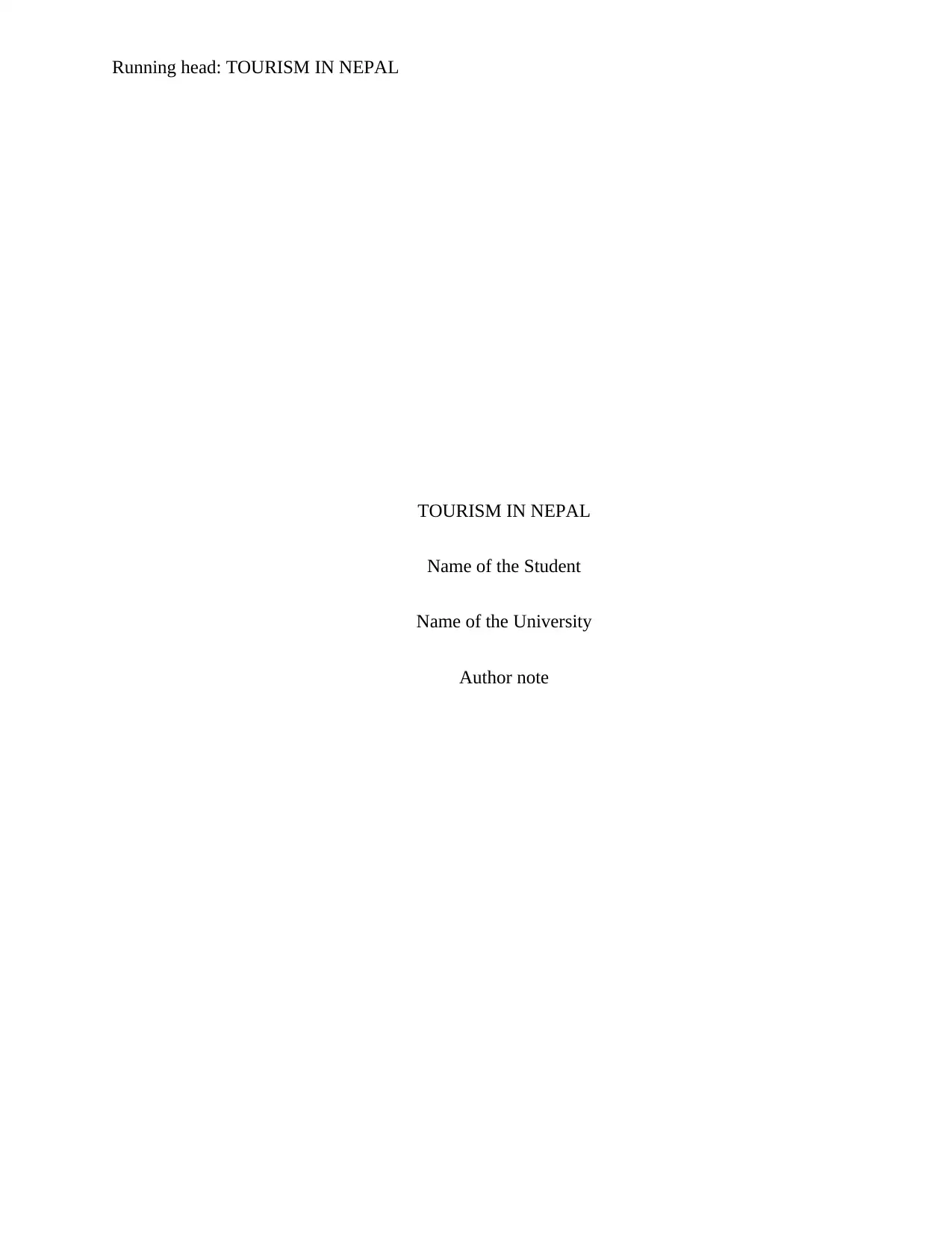
Running head: TOURISM IN NEPAL
TOURISM IN NEPAL
Name of the Student
Name of the University
Author note
TOURISM IN NEPAL
Name of the Student
Name of the University
Author note
Paraphrase This Document
Need a fresh take? Get an instant paraphrase of this document with our AI Paraphraser
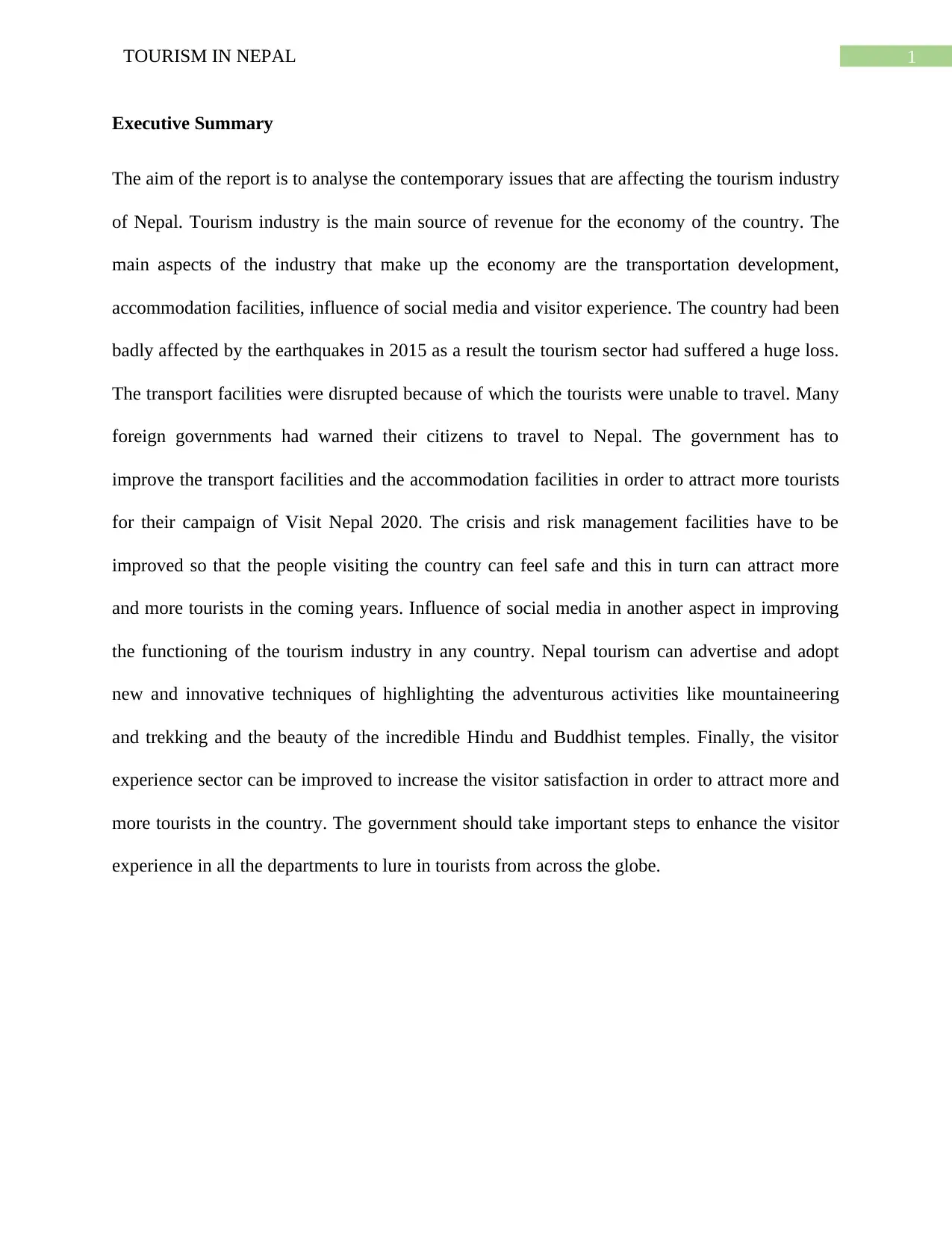
1TOURISM IN NEPAL
Executive Summary
The aim of the report is to analyse the contemporary issues that are affecting the tourism industry
of Nepal. Tourism industry is the main source of revenue for the economy of the country. The
main aspects of the industry that make up the economy are the transportation development,
accommodation facilities, influence of social media and visitor experience. The country had been
badly affected by the earthquakes in 2015 as a result the tourism sector had suffered a huge loss.
The transport facilities were disrupted because of which the tourists were unable to travel. Many
foreign governments had warned their citizens to travel to Nepal. The government has to
improve the transport facilities and the accommodation facilities in order to attract more tourists
for their campaign of Visit Nepal 2020. The crisis and risk management facilities have to be
improved so that the people visiting the country can feel safe and this in turn can attract more
and more tourists in the coming years. Influence of social media in another aspect in improving
the functioning of the tourism industry in any country. Nepal tourism can advertise and adopt
new and innovative techniques of highlighting the adventurous activities like mountaineering
and trekking and the beauty of the incredible Hindu and Buddhist temples. Finally, the visitor
experience sector can be improved to increase the visitor satisfaction in order to attract more and
more tourists in the country. The government should take important steps to enhance the visitor
experience in all the departments to lure in tourists from across the globe.
Executive Summary
The aim of the report is to analyse the contemporary issues that are affecting the tourism industry
of Nepal. Tourism industry is the main source of revenue for the economy of the country. The
main aspects of the industry that make up the economy are the transportation development,
accommodation facilities, influence of social media and visitor experience. The country had been
badly affected by the earthquakes in 2015 as a result the tourism sector had suffered a huge loss.
The transport facilities were disrupted because of which the tourists were unable to travel. Many
foreign governments had warned their citizens to travel to Nepal. The government has to
improve the transport facilities and the accommodation facilities in order to attract more tourists
for their campaign of Visit Nepal 2020. The crisis and risk management facilities have to be
improved so that the people visiting the country can feel safe and this in turn can attract more
and more tourists in the coming years. Influence of social media in another aspect in improving
the functioning of the tourism industry in any country. Nepal tourism can advertise and adopt
new and innovative techniques of highlighting the adventurous activities like mountaineering
and trekking and the beauty of the incredible Hindu and Buddhist temples. Finally, the visitor
experience sector can be improved to increase the visitor satisfaction in order to attract more and
more tourists in the country. The government should take important steps to enhance the visitor
experience in all the departments to lure in tourists from across the globe.
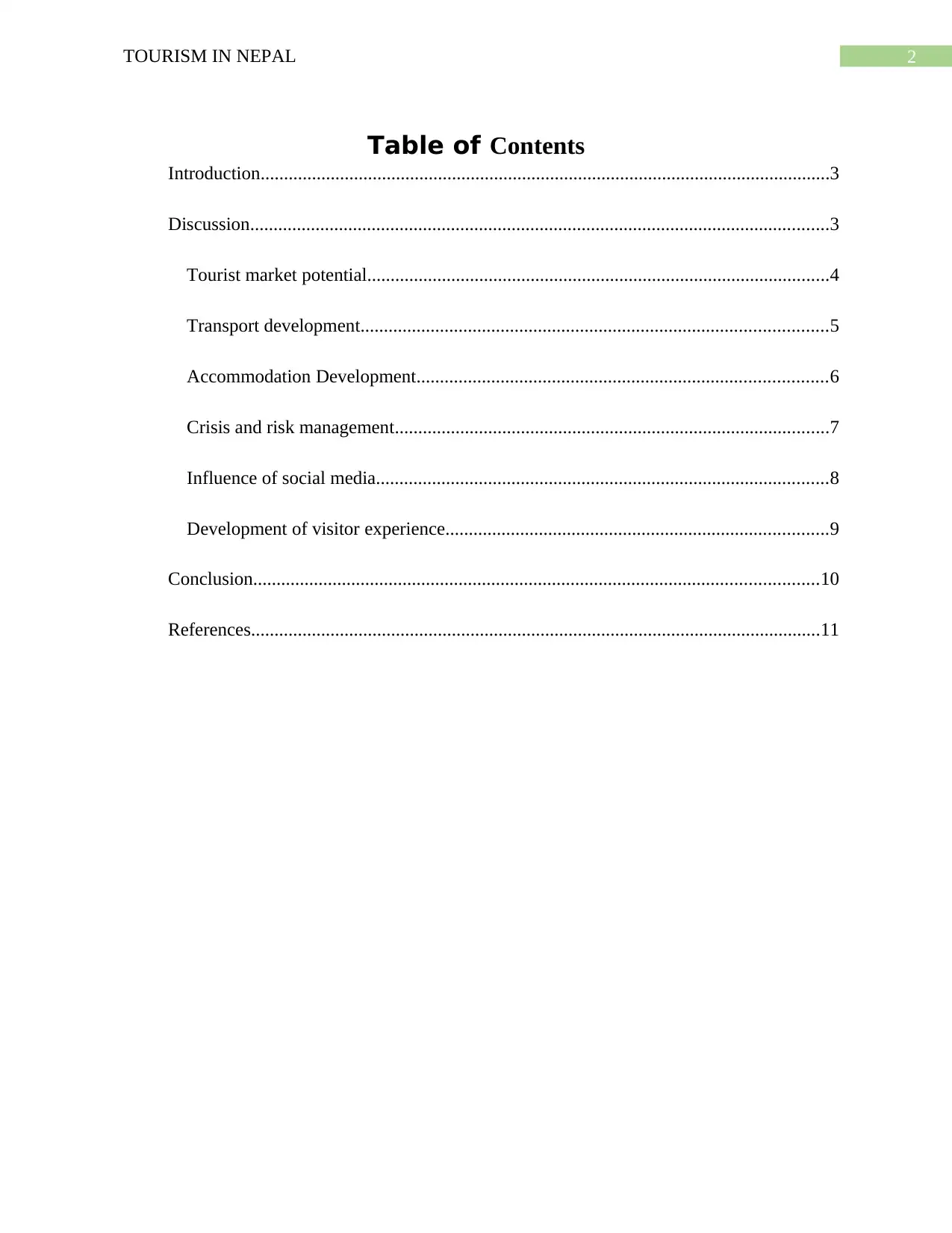
2TOURISM IN NEPAL
Table of Contents
Introduction..........................................................................................................................3
Discussion............................................................................................................................3
Tourist market potential...................................................................................................4
Transport development....................................................................................................5
Accommodation Development........................................................................................6
Crisis and risk management.............................................................................................7
Influence of social media.................................................................................................8
Development of visitor experience..................................................................................9
Conclusion.........................................................................................................................10
References..........................................................................................................................11
Table of Contents
Introduction..........................................................................................................................3
Discussion............................................................................................................................3
Tourist market potential...................................................................................................4
Transport development....................................................................................................5
Accommodation Development........................................................................................6
Crisis and risk management.............................................................................................7
Influence of social media.................................................................................................8
Development of visitor experience..................................................................................9
Conclusion.........................................................................................................................10
References..........................................................................................................................11
⊘ This is a preview!⊘
Do you want full access?
Subscribe today to unlock all pages.

Trusted by 1+ million students worldwide
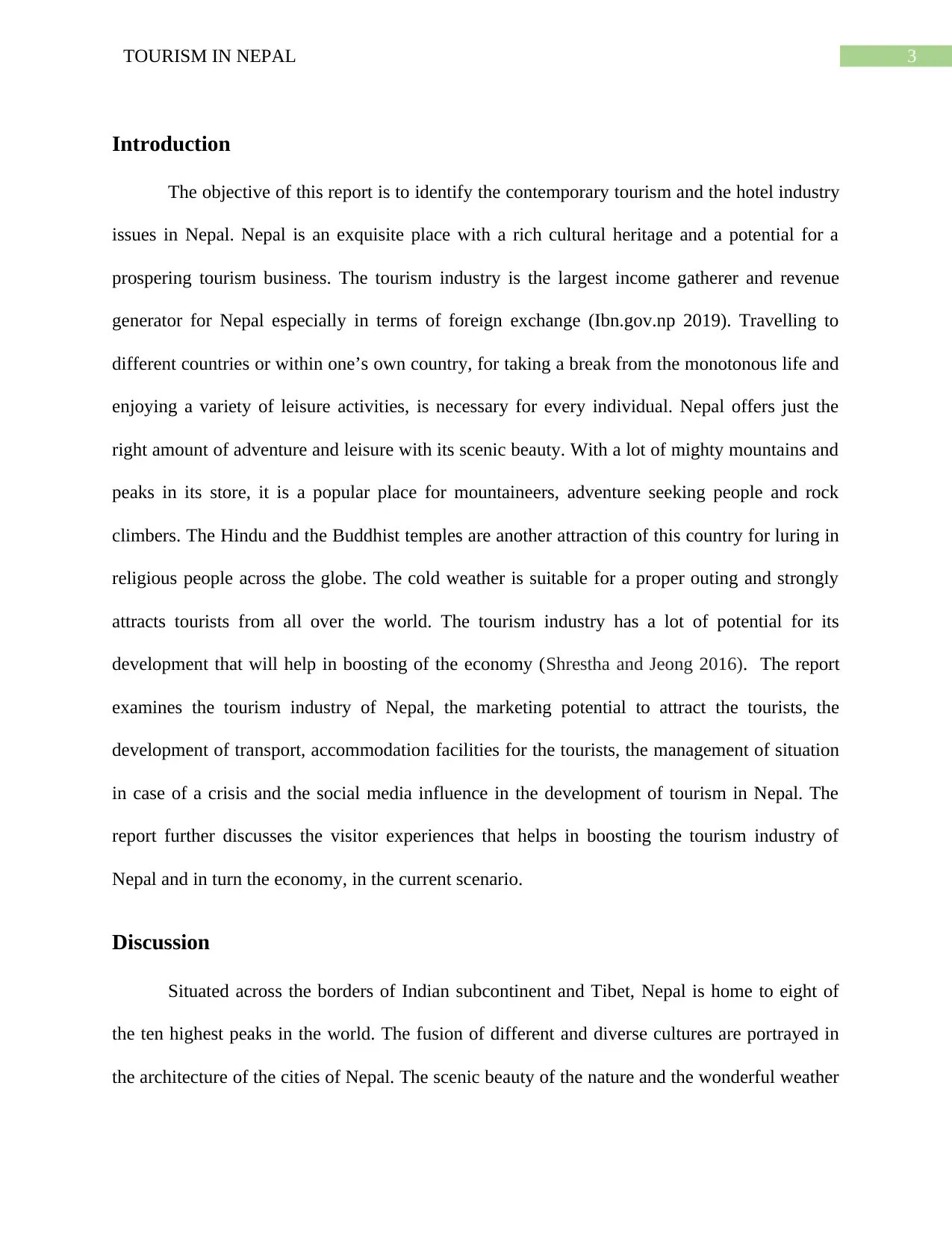
3TOURISM IN NEPAL
Introduction
The objective of this report is to identify the contemporary tourism and the hotel industry
issues in Nepal. Nepal is an exquisite place with a rich cultural heritage and a potential for a
prospering tourism business. The tourism industry is the largest income gatherer and revenue
generator for Nepal especially in terms of foreign exchange (Ibn.gov.np 2019). Travelling to
different countries or within one’s own country, for taking a break from the monotonous life and
enjoying a variety of leisure activities, is necessary for every individual. Nepal offers just the
right amount of adventure and leisure with its scenic beauty. With a lot of mighty mountains and
peaks in its store, it is a popular place for mountaineers, adventure seeking people and rock
climbers. The Hindu and the Buddhist temples are another attraction of this country for luring in
religious people across the globe. The cold weather is suitable for a proper outing and strongly
attracts tourists from all over the world. The tourism industry has a lot of potential for its
development that will help in boosting of the economy (Shrestha and Jeong 2016). The report
examines the tourism industry of Nepal, the marketing potential to attract the tourists, the
development of transport, accommodation facilities for the tourists, the management of situation
in case of a crisis and the social media influence in the development of tourism in Nepal. The
report further discusses the visitor experiences that helps in boosting the tourism industry of
Nepal and in turn the economy, in the current scenario.
Discussion
Situated across the borders of Indian subcontinent and Tibet, Nepal is home to eight of
the ten highest peaks in the world. The fusion of different and diverse cultures are portrayed in
the architecture of the cities of Nepal. The scenic beauty of the nature and the wonderful weather
Introduction
The objective of this report is to identify the contemporary tourism and the hotel industry
issues in Nepal. Nepal is an exquisite place with a rich cultural heritage and a potential for a
prospering tourism business. The tourism industry is the largest income gatherer and revenue
generator for Nepal especially in terms of foreign exchange (Ibn.gov.np 2019). Travelling to
different countries or within one’s own country, for taking a break from the monotonous life and
enjoying a variety of leisure activities, is necessary for every individual. Nepal offers just the
right amount of adventure and leisure with its scenic beauty. With a lot of mighty mountains and
peaks in its store, it is a popular place for mountaineers, adventure seeking people and rock
climbers. The Hindu and the Buddhist temples are another attraction of this country for luring in
religious people across the globe. The cold weather is suitable for a proper outing and strongly
attracts tourists from all over the world. The tourism industry has a lot of potential for its
development that will help in boosting of the economy (Shrestha and Jeong 2016). The report
examines the tourism industry of Nepal, the marketing potential to attract the tourists, the
development of transport, accommodation facilities for the tourists, the management of situation
in case of a crisis and the social media influence in the development of tourism in Nepal. The
report further discusses the visitor experiences that helps in boosting the tourism industry of
Nepal and in turn the economy, in the current scenario.
Discussion
Situated across the borders of Indian subcontinent and Tibet, Nepal is home to eight of
the ten highest peaks in the world. The fusion of different and diverse cultures are portrayed in
the architecture of the cities of Nepal. The scenic beauty of the nature and the wonderful weather
Paraphrase This Document
Need a fresh take? Get an instant paraphrase of this document with our AI Paraphraser
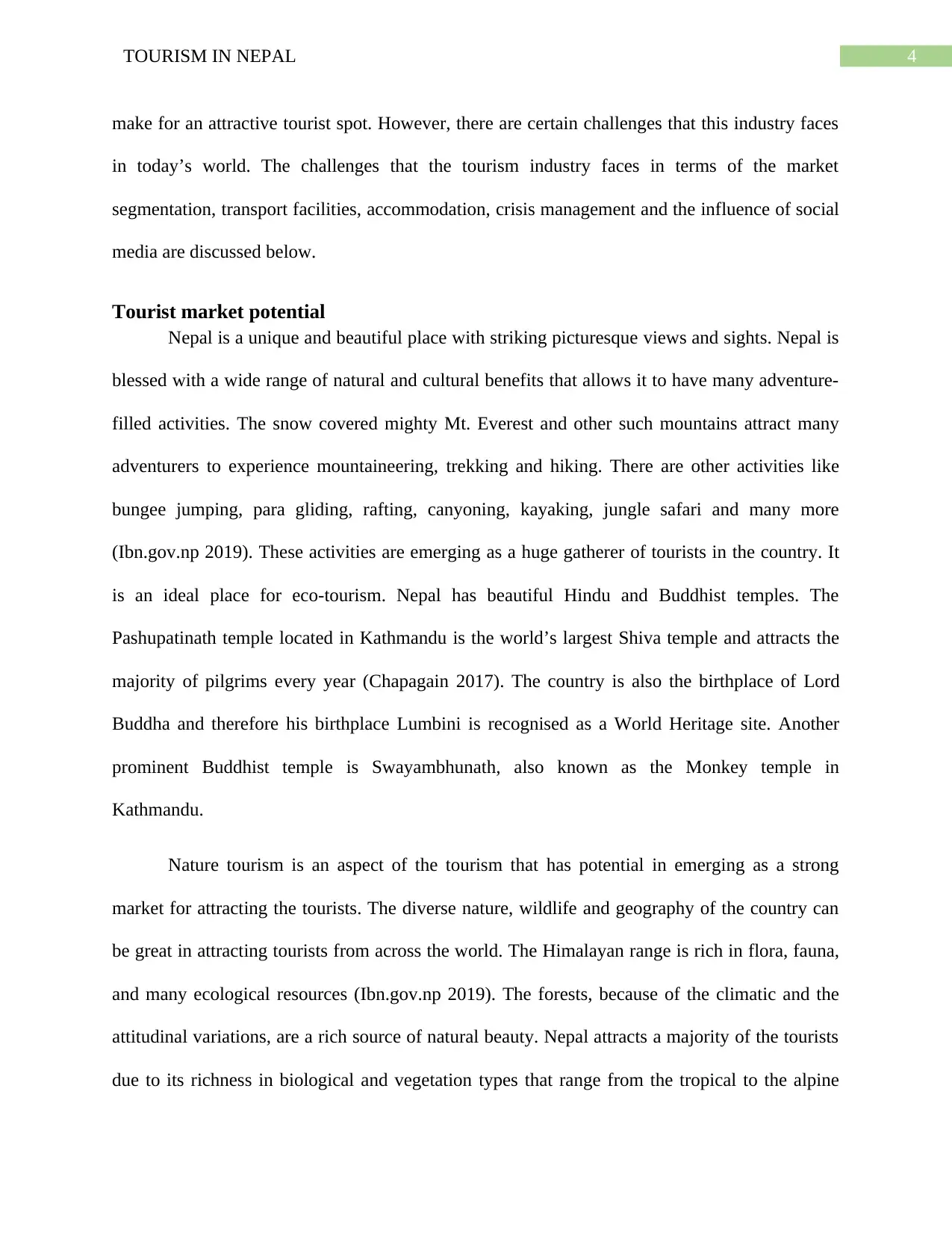
4TOURISM IN NEPAL
make for an attractive tourist spot. However, there are certain challenges that this industry faces
in today’s world. The challenges that the tourism industry faces in terms of the market
segmentation, transport facilities, accommodation, crisis management and the influence of social
media are discussed below.
Tourist market potential
Nepal is a unique and beautiful place with striking picturesque views and sights. Nepal is
blessed with a wide range of natural and cultural benefits that allows it to have many adventure-
filled activities. The snow covered mighty Mt. Everest and other such mountains attract many
adventurers to experience mountaineering, trekking and hiking. There are other activities like
bungee jumping, para gliding, rafting, canyoning, kayaking, jungle safari and many more
(Ibn.gov.np 2019). These activities are emerging as a huge gatherer of tourists in the country. It
is an ideal place for eco-tourism. Nepal has beautiful Hindu and Buddhist temples. The
Pashupatinath temple located in Kathmandu is the world’s largest Shiva temple and attracts the
majority of pilgrims every year (Chapagain 2017). The country is also the birthplace of Lord
Buddha and therefore his birthplace Lumbini is recognised as a World Heritage site. Another
prominent Buddhist temple is Swayambhunath, also known as the Monkey temple in
Kathmandu.
Nature tourism is an aspect of the tourism that has potential in emerging as a strong
market for attracting the tourists. The diverse nature, wildlife and geography of the country can
be great in attracting tourists from across the world. The Himalayan range is rich in flora, fauna,
and many ecological resources (Ibn.gov.np 2019). The forests, because of the climatic and the
attitudinal variations, are a rich source of natural beauty. Nepal attracts a majority of the tourists
due to its richness in biological and vegetation types that range from the tropical to the alpine
make for an attractive tourist spot. However, there are certain challenges that this industry faces
in today’s world. The challenges that the tourism industry faces in terms of the market
segmentation, transport facilities, accommodation, crisis management and the influence of social
media are discussed below.
Tourist market potential
Nepal is a unique and beautiful place with striking picturesque views and sights. Nepal is
blessed with a wide range of natural and cultural benefits that allows it to have many adventure-
filled activities. The snow covered mighty Mt. Everest and other such mountains attract many
adventurers to experience mountaineering, trekking and hiking. There are other activities like
bungee jumping, para gliding, rafting, canyoning, kayaking, jungle safari and many more
(Ibn.gov.np 2019). These activities are emerging as a huge gatherer of tourists in the country. It
is an ideal place for eco-tourism. Nepal has beautiful Hindu and Buddhist temples. The
Pashupatinath temple located in Kathmandu is the world’s largest Shiva temple and attracts the
majority of pilgrims every year (Chapagain 2017). The country is also the birthplace of Lord
Buddha and therefore his birthplace Lumbini is recognised as a World Heritage site. Another
prominent Buddhist temple is Swayambhunath, also known as the Monkey temple in
Kathmandu.
Nature tourism is an aspect of the tourism that has potential in emerging as a strong
market for attracting the tourists. The diverse nature, wildlife and geography of the country can
be great in attracting tourists from across the world. The Himalayan range is rich in flora, fauna,
and many ecological resources (Ibn.gov.np 2019). The forests, because of the climatic and the
attitudinal variations, are a rich source of natural beauty. Nepal attracts a majority of the tourists
due to its richness in biological and vegetation types that range from the tropical to the alpine
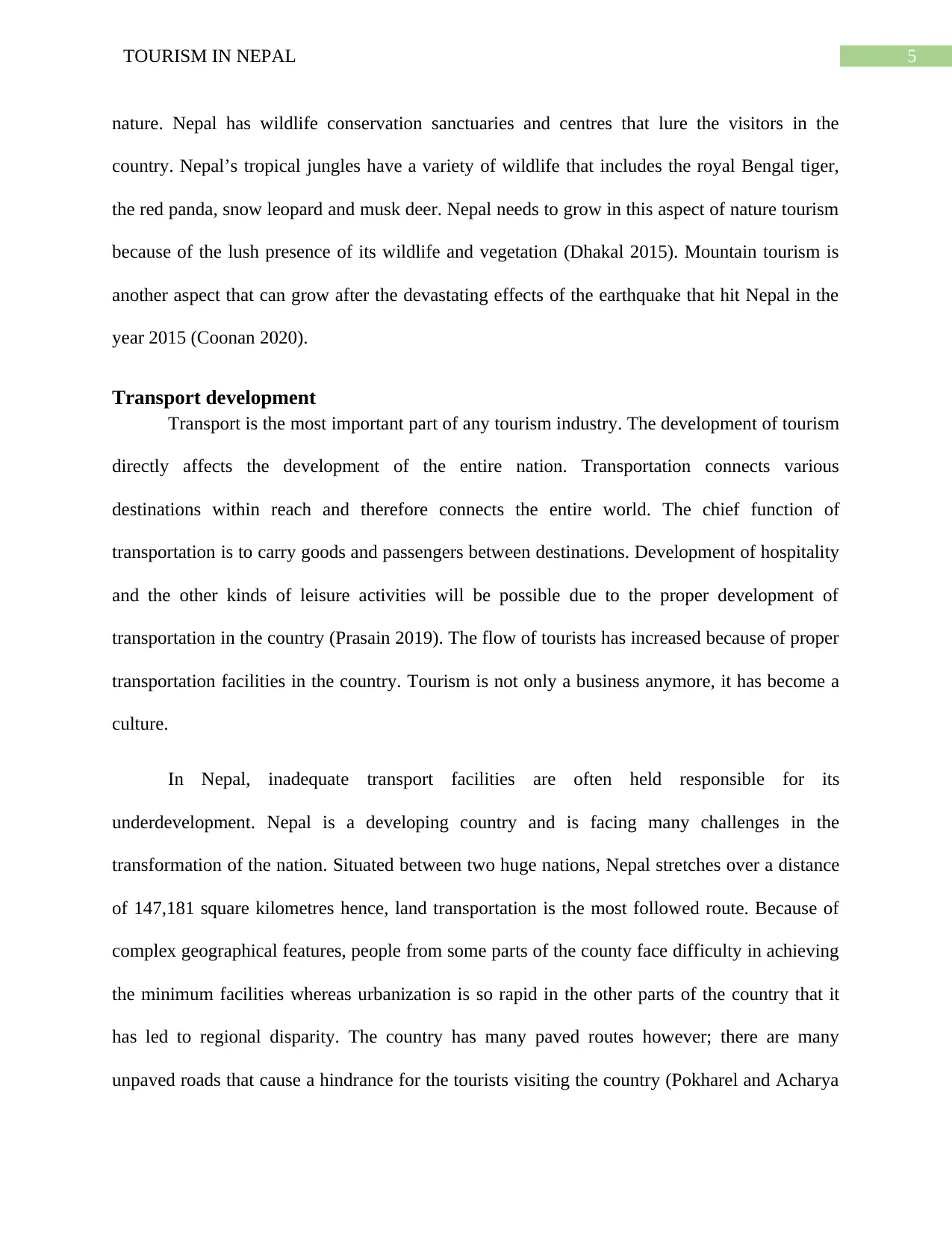
5TOURISM IN NEPAL
nature. Nepal has wildlife conservation sanctuaries and centres that lure the visitors in the
country. Nepal’s tropical jungles have a variety of wildlife that includes the royal Bengal tiger,
the red panda, snow leopard and musk deer. Nepal needs to grow in this aspect of nature tourism
because of the lush presence of its wildlife and vegetation (Dhakal 2015). Mountain tourism is
another aspect that can grow after the devastating effects of the earthquake that hit Nepal in the
year 2015 (Coonan 2020).
Transport development
Transport is the most important part of any tourism industry. The development of tourism
directly affects the development of the entire nation. Transportation connects various
destinations within reach and therefore connects the entire world. The chief function of
transportation is to carry goods and passengers between destinations. Development of hospitality
and the other kinds of leisure activities will be possible due to the proper development of
transportation in the country (Prasain 2019). The flow of tourists has increased because of proper
transportation facilities in the country. Tourism is not only a business anymore, it has become a
culture.
In Nepal, inadequate transport facilities are often held responsible for its
underdevelopment. Nepal is a developing country and is facing many challenges in the
transformation of the nation. Situated between two huge nations, Nepal stretches over a distance
of 147,181 square kilometres hence, land transportation is the most followed route. Because of
complex geographical features, people from some parts of the county face difficulty in achieving
the minimum facilities whereas urbanization is so rapid in the other parts of the country that it
has led to regional disparity. The country has many paved routes however; there are many
unpaved roads that cause a hindrance for the tourists visiting the country (Pokharel and Acharya
nature. Nepal has wildlife conservation sanctuaries and centres that lure the visitors in the
country. Nepal’s tropical jungles have a variety of wildlife that includes the royal Bengal tiger,
the red panda, snow leopard and musk deer. Nepal needs to grow in this aspect of nature tourism
because of the lush presence of its wildlife and vegetation (Dhakal 2015). Mountain tourism is
another aspect that can grow after the devastating effects of the earthquake that hit Nepal in the
year 2015 (Coonan 2020).
Transport development
Transport is the most important part of any tourism industry. The development of tourism
directly affects the development of the entire nation. Transportation connects various
destinations within reach and therefore connects the entire world. The chief function of
transportation is to carry goods and passengers between destinations. Development of hospitality
and the other kinds of leisure activities will be possible due to the proper development of
transportation in the country (Prasain 2019). The flow of tourists has increased because of proper
transportation facilities in the country. Tourism is not only a business anymore, it has become a
culture.
In Nepal, inadequate transport facilities are often held responsible for its
underdevelopment. Nepal is a developing country and is facing many challenges in the
transformation of the nation. Situated between two huge nations, Nepal stretches over a distance
of 147,181 square kilometres hence, land transportation is the most followed route. Because of
complex geographical features, people from some parts of the county face difficulty in achieving
the minimum facilities whereas urbanization is so rapid in the other parts of the country that it
has led to regional disparity. The country has many paved routes however; there are many
unpaved roads that cause a hindrance for the tourists visiting the country (Pokharel and Acharya
⊘ This is a preview!⊘
Do you want full access?
Subscribe today to unlock all pages.

Trusted by 1+ million students worldwide
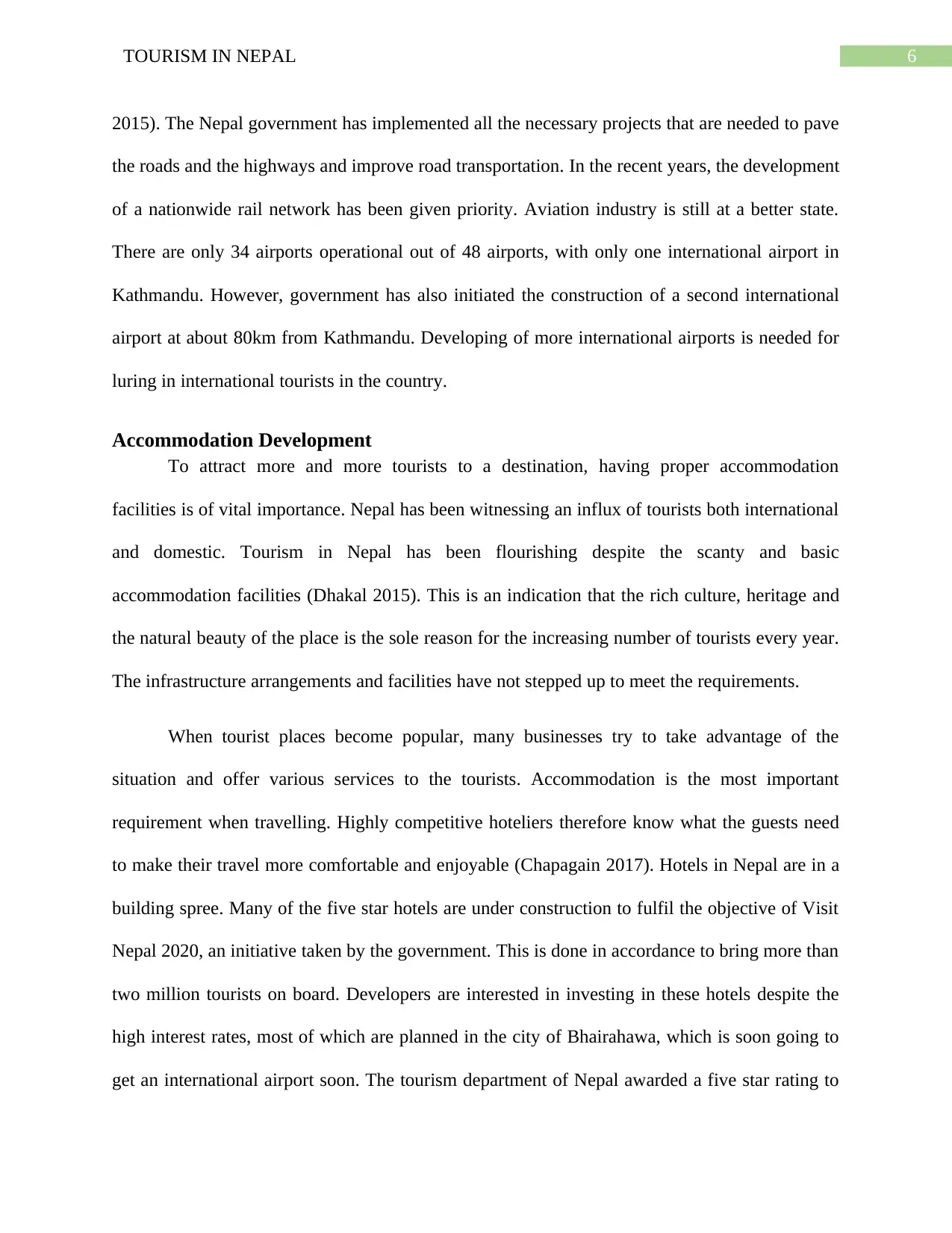
6TOURISM IN NEPAL
2015). The Nepal government has implemented all the necessary projects that are needed to pave
the roads and the highways and improve road transportation. In the recent years, the development
of a nationwide rail network has been given priority. Aviation industry is still at a better state.
There are only 34 airports operational out of 48 airports, with only one international airport in
Kathmandu. However, government has also initiated the construction of a second international
airport at about 80km from Kathmandu. Developing of more international airports is needed for
luring in international tourists in the country.
Accommodation Development
To attract more and more tourists to a destination, having proper accommodation
facilities is of vital importance. Nepal has been witnessing an influx of tourists both international
and domestic. Tourism in Nepal has been flourishing despite the scanty and basic
accommodation facilities (Dhakal 2015). This is an indication that the rich culture, heritage and
the natural beauty of the place is the sole reason for the increasing number of tourists every year.
The infrastructure arrangements and facilities have not stepped up to meet the requirements.
When tourist places become popular, many businesses try to take advantage of the
situation and offer various services to the tourists. Accommodation is the most important
requirement when travelling. Highly competitive hoteliers therefore know what the guests need
to make their travel more comfortable and enjoyable (Chapagain 2017). Hotels in Nepal are in a
building spree. Many of the five star hotels are under construction to fulfil the objective of Visit
Nepal 2020, an initiative taken by the government. This is done in accordance to bring more than
two million tourists on board. Developers are interested in investing in these hotels despite the
high interest rates, most of which are planned in the city of Bhairahawa, which is soon going to
get an international airport soon. The tourism department of Nepal awarded a five star rating to
2015). The Nepal government has implemented all the necessary projects that are needed to pave
the roads and the highways and improve road transportation. In the recent years, the development
of a nationwide rail network has been given priority. Aviation industry is still at a better state.
There are only 34 airports operational out of 48 airports, with only one international airport in
Kathmandu. However, government has also initiated the construction of a second international
airport at about 80km from Kathmandu. Developing of more international airports is needed for
luring in international tourists in the country.
Accommodation Development
To attract more and more tourists to a destination, having proper accommodation
facilities is of vital importance. Nepal has been witnessing an influx of tourists both international
and domestic. Tourism in Nepal has been flourishing despite the scanty and basic
accommodation facilities (Dhakal 2015). This is an indication that the rich culture, heritage and
the natural beauty of the place is the sole reason for the increasing number of tourists every year.
The infrastructure arrangements and facilities have not stepped up to meet the requirements.
When tourist places become popular, many businesses try to take advantage of the
situation and offer various services to the tourists. Accommodation is the most important
requirement when travelling. Highly competitive hoteliers therefore know what the guests need
to make their travel more comfortable and enjoyable (Chapagain 2017). Hotels in Nepal are in a
building spree. Many of the five star hotels are under construction to fulfil the objective of Visit
Nepal 2020, an initiative taken by the government. This is done in accordance to bring more than
two million tourists on board. Developers are interested in investing in these hotels despite the
high interest rates, most of which are planned in the city of Bhairahawa, which is soon going to
get an international airport soon. The tourism department of Nepal awarded a five star rating to
Paraphrase This Document
Need a fresh take? Get an instant paraphrase of this document with our AI Paraphraser
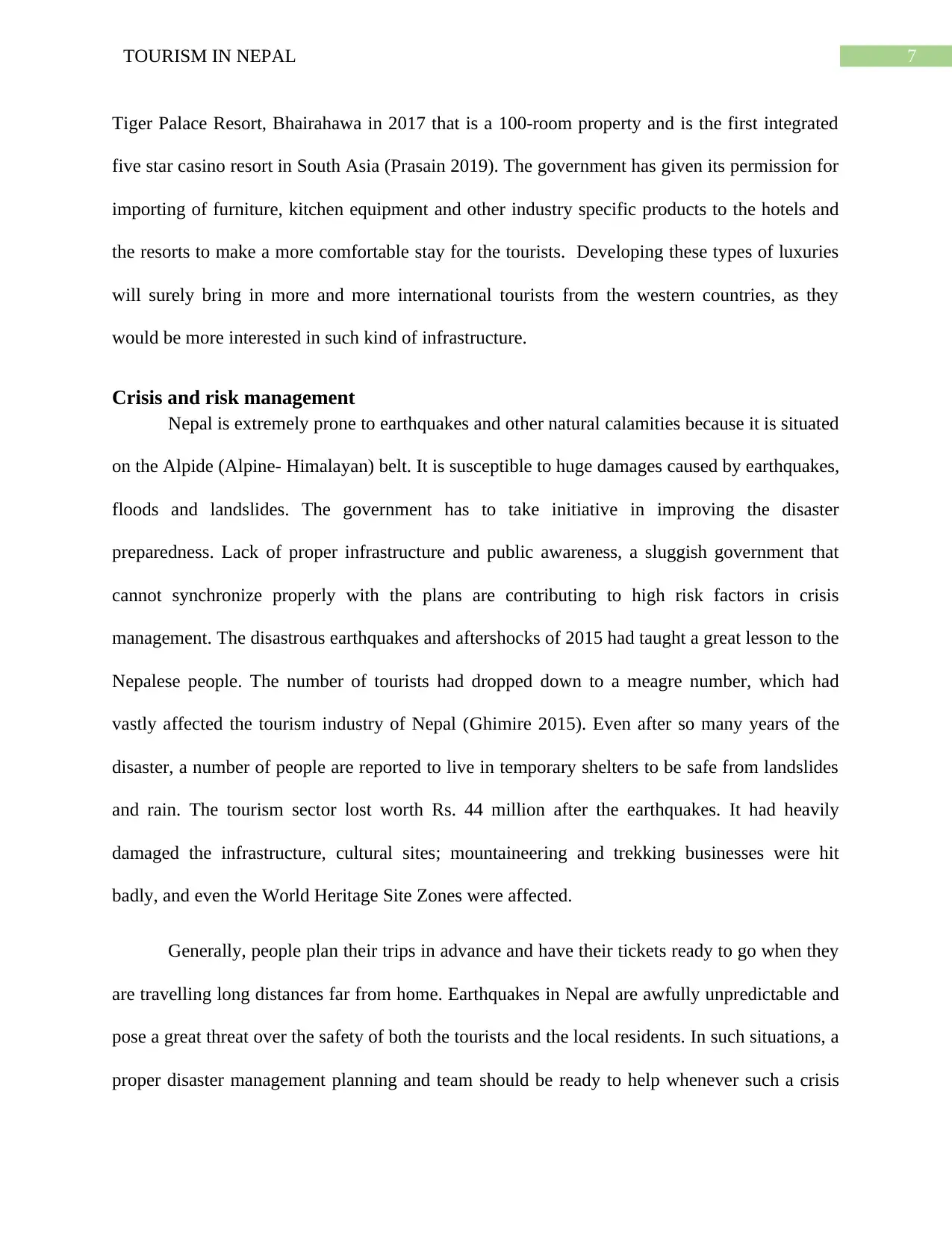
7TOURISM IN NEPAL
Tiger Palace Resort, Bhairahawa in 2017 that is a 100-room property and is the first integrated
five star casino resort in South Asia (Prasain 2019). The government has given its permission for
importing of furniture, kitchen equipment and other industry specific products to the hotels and
the resorts to make a more comfortable stay for the tourists. Developing these types of luxuries
will surely bring in more and more international tourists from the western countries, as they
would be more interested in such kind of infrastructure.
Crisis and risk management
Nepal is extremely prone to earthquakes and other natural calamities because it is situated
on the Alpide (Alpine- Himalayan) belt. It is susceptible to huge damages caused by earthquakes,
floods and landslides. The government has to take initiative in improving the disaster
preparedness. Lack of proper infrastructure and public awareness, a sluggish government that
cannot synchronize properly with the plans are contributing to high risk factors in crisis
management. The disastrous earthquakes and aftershocks of 2015 had taught a great lesson to the
Nepalese people. The number of tourists had dropped down to a meagre number, which had
vastly affected the tourism industry of Nepal (Ghimire 2015). Even after so many years of the
disaster, a number of people are reported to live in temporary shelters to be safe from landslides
and rain. The tourism sector lost worth Rs. 44 million after the earthquakes. It had heavily
damaged the infrastructure, cultural sites; mountaineering and trekking businesses were hit
badly, and even the World Heritage Site Zones were affected.
Generally, people plan their trips in advance and have their tickets ready to go when they
are travelling long distances far from home. Earthquakes in Nepal are awfully unpredictable and
pose a great threat over the safety of both the tourists and the local residents. In such situations, a
proper disaster management planning and team should be ready to help whenever such a crisis
Tiger Palace Resort, Bhairahawa in 2017 that is a 100-room property and is the first integrated
five star casino resort in South Asia (Prasain 2019). The government has given its permission for
importing of furniture, kitchen equipment and other industry specific products to the hotels and
the resorts to make a more comfortable stay for the tourists. Developing these types of luxuries
will surely bring in more and more international tourists from the western countries, as they
would be more interested in such kind of infrastructure.
Crisis and risk management
Nepal is extremely prone to earthquakes and other natural calamities because it is situated
on the Alpide (Alpine- Himalayan) belt. It is susceptible to huge damages caused by earthquakes,
floods and landslides. The government has to take initiative in improving the disaster
preparedness. Lack of proper infrastructure and public awareness, a sluggish government that
cannot synchronize properly with the plans are contributing to high risk factors in crisis
management. The disastrous earthquakes and aftershocks of 2015 had taught a great lesson to the
Nepalese people. The number of tourists had dropped down to a meagre number, which had
vastly affected the tourism industry of Nepal (Ghimire 2015). Even after so many years of the
disaster, a number of people are reported to live in temporary shelters to be safe from landslides
and rain. The tourism sector lost worth Rs. 44 million after the earthquakes. It had heavily
damaged the infrastructure, cultural sites; mountaineering and trekking businesses were hit
badly, and even the World Heritage Site Zones were affected.
Generally, people plan their trips in advance and have their tickets ready to go when they
are travelling long distances far from home. Earthquakes in Nepal are awfully unpredictable and
pose a great threat over the safety of both the tourists and the local residents. In such situations, a
proper disaster management planning and team should be ready to help whenever such a crisis
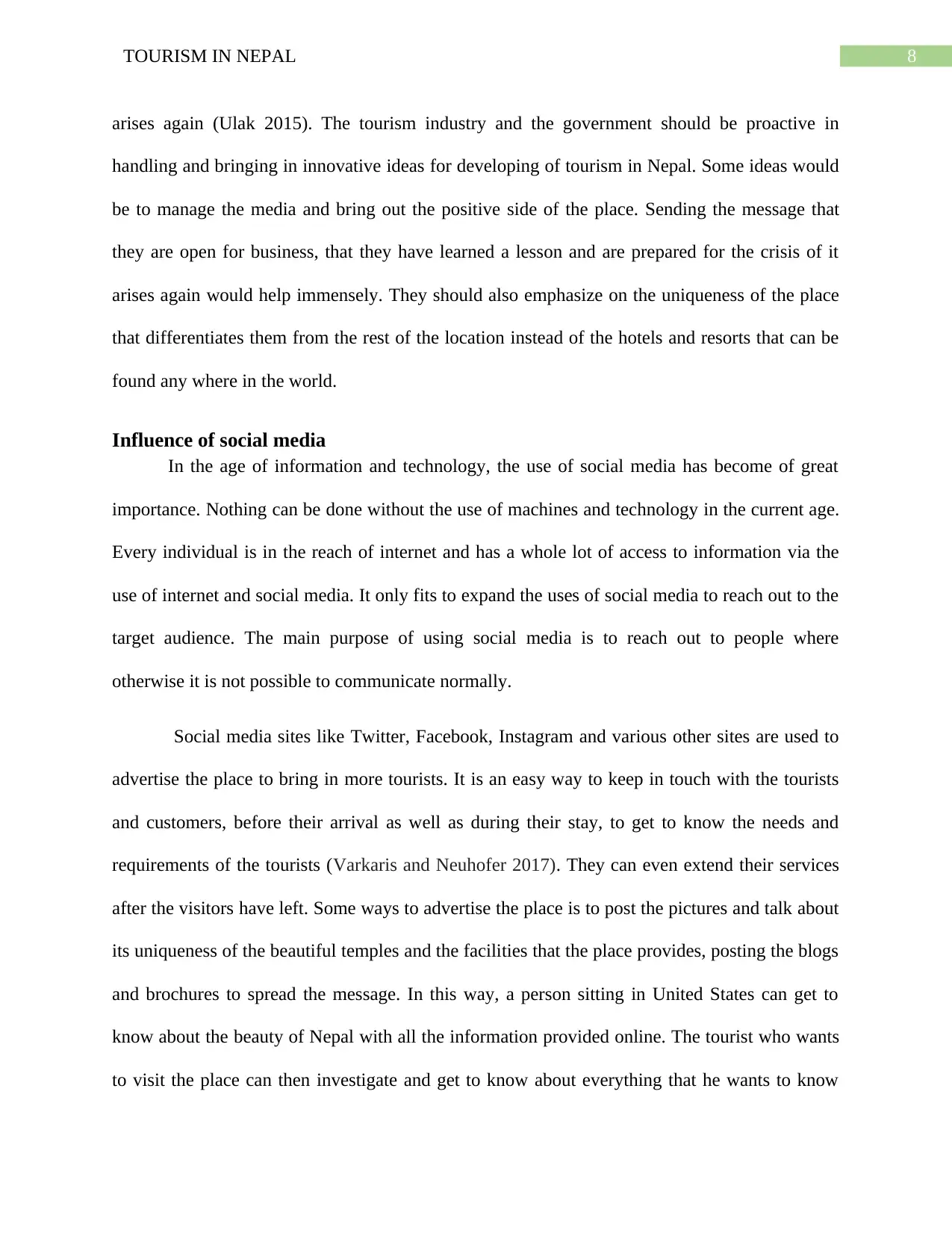
8TOURISM IN NEPAL
arises again (Ulak 2015). The tourism industry and the government should be proactive in
handling and bringing in innovative ideas for developing of tourism in Nepal. Some ideas would
be to manage the media and bring out the positive side of the place. Sending the message that
they are open for business, that they have learned a lesson and are prepared for the crisis of it
arises again would help immensely. They should also emphasize on the uniqueness of the place
that differentiates them from the rest of the location instead of the hotels and resorts that can be
found any where in the world.
Influence of social media
In the age of information and technology, the use of social media has become of great
importance. Nothing can be done without the use of machines and technology in the current age.
Every individual is in the reach of internet and has a whole lot of access to information via the
use of internet and social media. It only fits to expand the uses of social media to reach out to the
target audience. The main purpose of using social media is to reach out to people where
otherwise it is not possible to communicate normally.
Social media sites like Twitter, Facebook, Instagram and various other sites are used to
advertise the place to bring in more tourists. It is an easy way to keep in touch with the tourists
and customers, before their arrival as well as during their stay, to get to know the needs and
requirements of the tourists (Varkaris and Neuhofer 2017). They can even extend their services
after the visitors have left. Some ways to advertise the place is to post the pictures and talk about
its uniqueness of the beautiful temples and the facilities that the place provides, posting the blogs
and brochures to spread the message. In this way, a person sitting in United States can get to
know about the beauty of Nepal with all the information provided online. The tourist who wants
to visit the place can then investigate and get to know about everything that he wants to know
arises again (Ulak 2015). The tourism industry and the government should be proactive in
handling and bringing in innovative ideas for developing of tourism in Nepal. Some ideas would
be to manage the media and bring out the positive side of the place. Sending the message that
they are open for business, that they have learned a lesson and are prepared for the crisis of it
arises again would help immensely. They should also emphasize on the uniqueness of the place
that differentiates them from the rest of the location instead of the hotels and resorts that can be
found any where in the world.
Influence of social media
In the age of information and technology, the use of social media has become of great
importance. Nothing can be done without the use of machines and technology in the current age.
Every individual is in the reach of internet and has a whole lot of access to information via the
use of internet and social media. It only fits to expand the uses of social media to reach out to the
target audience. The main purpose of using social media is to reach out to people where
otherwise it is not possible to communicate normally.
Social media sites like Twitter, Facebook, Instagram and various other sites are used to
advertise the place to bring in more tourists. It is an easy way to keep in touch with the tourists
and customers, before their arrival as well as during their stay, to get to know the needs and
requirements of the tourists (Varkaris and Neuhofer 2017). They can even extend their services
after the visitors have left. Some ways to advertise the place is to post the pictures and talk about
its uniqueness of the beautiful temples and the facilities that the place provides, posting the blogs
and brochures to spread the message. In this way, a person sitting in United States can get to
know about the beauty of Nepal with all the information provided online. The tourist who wants
to visit the place can then investigate and get to know about everything that he wants to know
⊘ This is a preview!⊘
Do you want full access?
Subscribe today to unlock all pages.

Trusted by 1+ million students worldwide
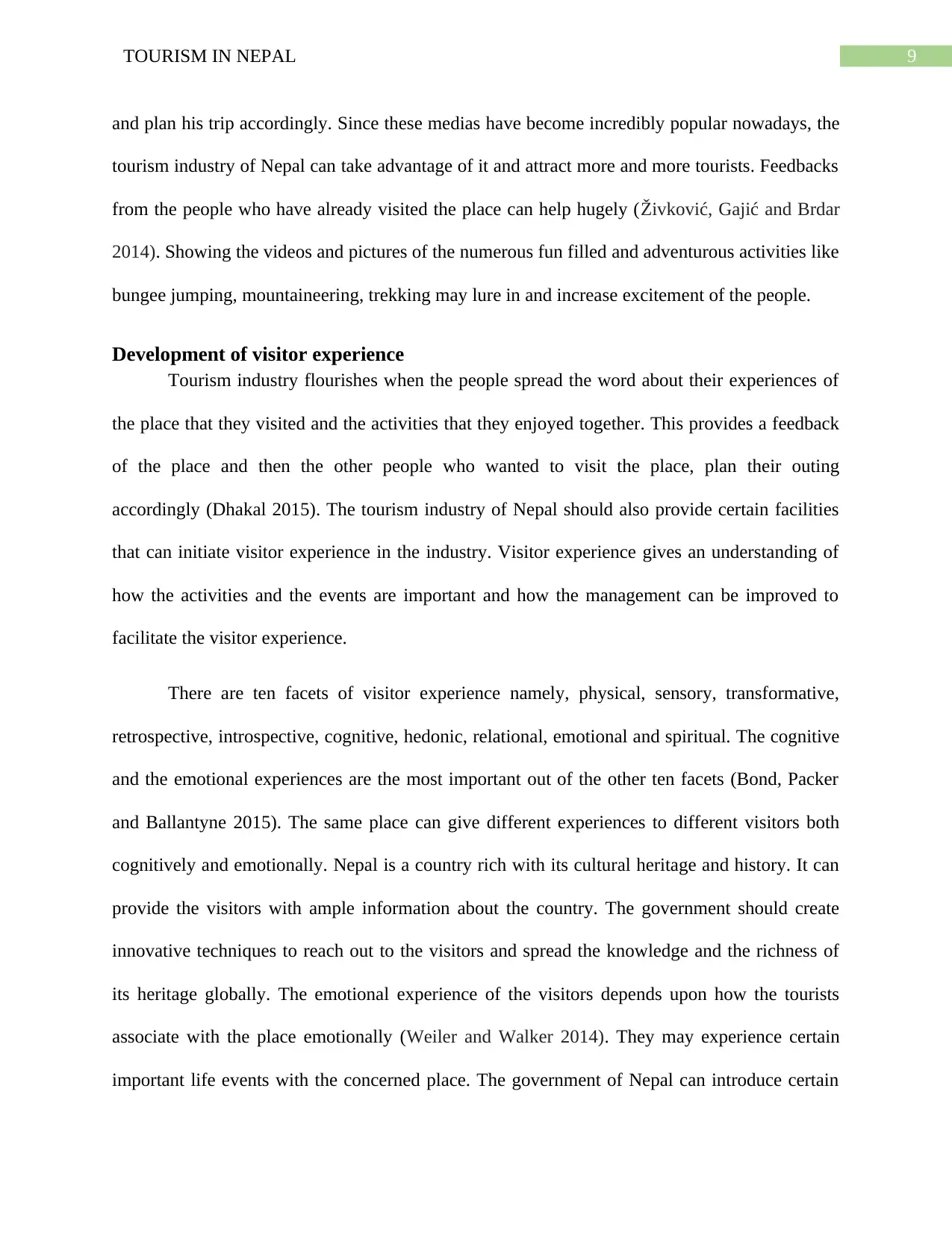
9TOURISM IN NEPAL
and plan his trip accordingly. Since these medias have become incredibly popular nowadays, the
tourism industry of Nepal can take advantage of it and attract more and more tourists. Feedbacks
from the people who have already visited the place can help hugely (Živković, Gajić and Brdar
2014). Showing the videos and pictures of the numerous fun filled and adventurous activities like
bungee jumping, mountaineering, trekking may lure in and increase excitement of the people.
Development of visitor experience
Tourism industry flourishes when the people spread the word about their experiences of
the place that they visited and the activities that they enjoyed together. This provides a feedback
of the place and then the other people who wanted to visit the place, plan their outing
accordingly (Dhakal 2015). The tourism industry of Nepal should also provide certain facilities
that can initiate visitor experience in the industry. Visitor experience gives an understanding of
how the activities and the events are important and how the management can be improved to
facilitate the visitor experience.
There are ten facets of visitor experience namely, physical, sensory, transformative,
retrospective, introspective, cognitive, hedonic, relational, emotional and spiritual. The cognitive
and the emotional experiences are the most important out of the other ten facets (Bond, Packer
and Ballantyne 2015). The same place can give different experiences to different visitors both
cognitively and emotionally. Nepal is a country rich with its cultural heritage and history. It can
provide the visitors with ample information about the country. The government should create
innovative techniques to reach out to the visitors and spread the knowledge and the richness of
its heritage globally. The emotional experience of the visitors depends upon how the tourists
associate with the place emotionally (Weiler and Walker 2014). They may experience certain
important life events with the concerned place. The government of Nepal can introduce certain
and plan his trip accordingly. Since these medias have become incredibly popular nowadays, the
tourism industry of Nepal can take advantage of it and attract more and more tourists. Feedbacks
from the people who have already visited the place can help hugely (Živković, Gajić and Brdar
2014). Showing the videos and pictures of the numerous fun filled and adventurous activities like
bungee jumping, mountaineering, trekking may lure in and increase excitement of the people.
Development of visitor experience
Tourism industry flourishes when the people spread the word about their experiences of
the place that they visited and the activities that they enjoyed together. This provides a feedback
of the place and then the other people who wanted to visit the place, plan their outing
accordingly (Dhakal 2015). The tourism industry of Nepal should also provide certain facilities
that can initiate visitor experience in the industry. Visitor experience gives an understanding of
how the activities and the events are important and how the management can be improved to
facilitate the visitor experience.
There are ten facets of visitor experience namely, physical, sensory, transformative,
retrospective, introspective, cognitive, hedonic, relational, emotional and spiritual. The cognitive
and the emotional experiences are the most important out of the other ten facets (Bond, Packer
and Ballantyne 2015). The same place can give different experiences to different visitors both
cognitively and emotionally. Nepal is a country rich with its cultural heritage and history. It can
provide the visitors with ample information about the country. The government should create
innovative techniques to reach out to the visitors and spread the knowledge and the richness of
its heritage globally. The emotional experience of the visitors depends upon how the tourists
associate with the place emotionally (Weiler and Walker 2014). They may experience certain
important life events with the concerned place. The government of Nepal can introduce certain
Paraphrase This Document
Need a fresh take? Get an instant paraphrase of this document with our AI Paraphraser
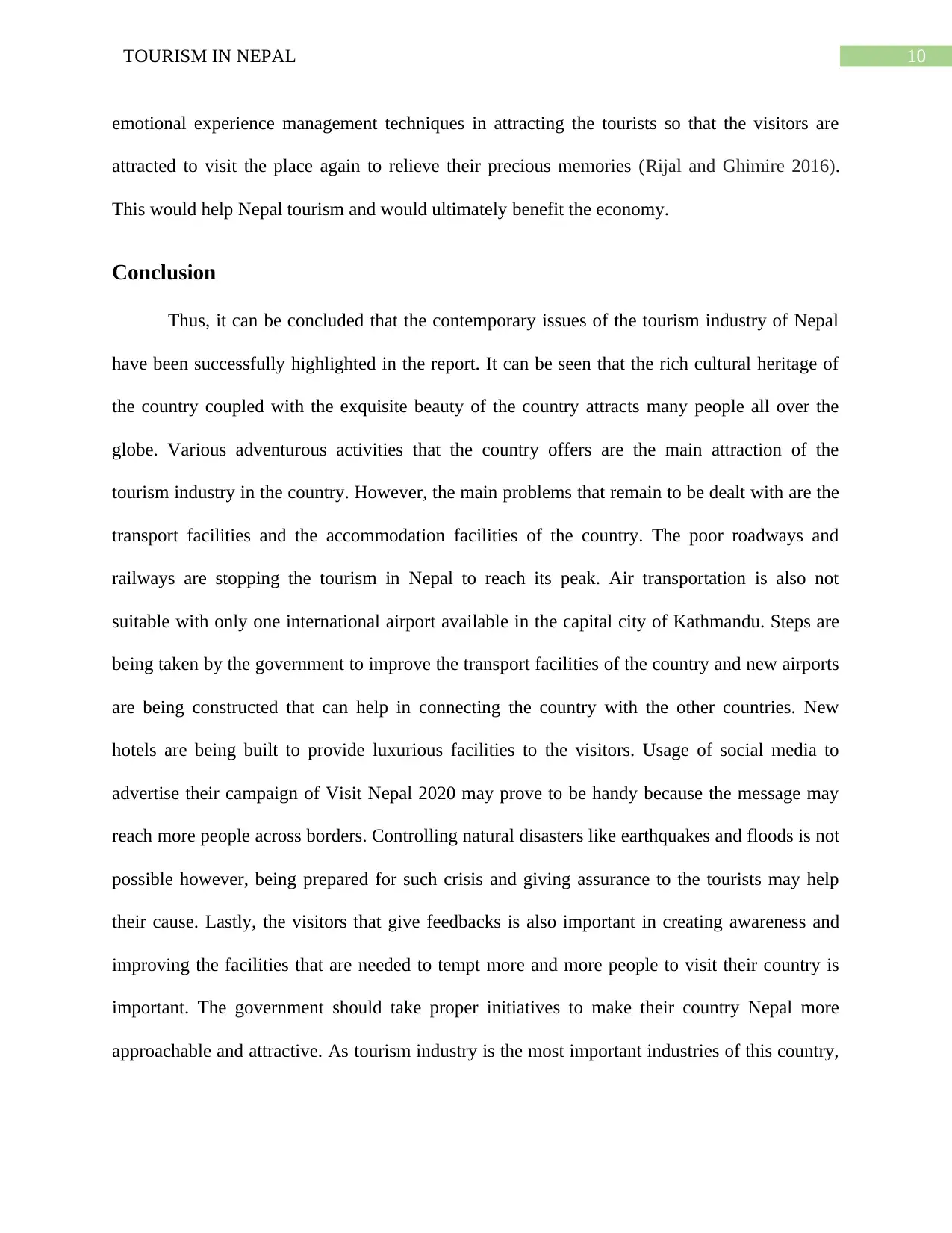
10TOURISM IN NEPAL
emotional experience management techniques in attracting the tourists so that the visitors are
attracted to visit the place again to relieve their precious memories (Rijal and Ghimire 2016).
This would help Nepal tourism and would ultimately benefit the economy.
Conclusion
Thus, it can be concluded that the contemporary issues of the tourism industry of Nepal
have been successfully highlighted in the report. It can be seen that the rich cultural heritage of
the country coupled with the exquisite beauty of the country attracts many people all over the
globe. Various adventurous activities that the country offers are the main attraction of the
tourism industry in the country. However, the main problems that remain to be dealt with are the
transport facilities and the accommodation facilities of the country. The poor roadways and
railways are stopping the tourism in Nepal to reach its peak. Air transportation is also not
suitable with only one international airport available in the capital city of Kathmandu. Steps are
being taken by the government to improve the transport facilities of the country and new airports
are being constructed that can help in connecting the country with the other countries. New
hotels are being built to provide luxurious facilities to the visitors. Usage of social media to
advertise their campaign of Visit Nepal 2020 may prove to be handy because the message may
reach more people across borders. Controlling natural disasters like earthquakes and floods is not
possible however, being prepared for such crisis and giving assurance to the tourists may help
their cause. Lastly, the visitors that give feedbacks is also important in creating awareness and
improving the facilities that are needed to tempt more and more people to visit their country is
important. The government should take proper initiatives to make their country Nepal more
approachable and attractive. As tourism industry is the most important industries of this country,
emotional experience management techniques in attracting the tourists so that the visitors are
attracted to visit the place again to relieve their precious memories (Rijal and Ghimire 2016).
This would help Nepal tourism and would ultimately benefit the economy.
Conclusion
Thus, it can be concluded that the contemporary issues of the tourism industry of Nepal
have been successfully highlighted in the report. It can be seen that the rich cultural heritage of
the country coupled with the exquisite beauty of the country attracts many people all over the
globe. Various adventurous activities that the country offers are the main attraction of the
tourism industry in the country. However, the main problems that remain to be dealt with are the
transport facilities and the accommodation facilities of the country. The poor roadways and
railways are stopping the tourism in Nepal to reach its peak. Air transportation is also not
suitable with only one international airport available in the capital city of Kathmandu. Steps are
being taken by the government to improve the transport facilities of the country and new airports
are being constructed that can help in connecting the country with the other countries. New
hotels are being built to provide luxurious facilities to the visitors. Usage of social media to
advertise their campaign of Visit Nepal 2020 may prove to be handy because the message may
reach more people across borders. Controlling natural disasters like earthquakes and floods is not
possible however, being prepared for such crisis and giving assurance to the tourists may help
their cause. Lastly, the visitors that give feedbacks is also important in creating awareness and
improving the facilities that are needed to tempt more and more people to visit their country is
important. The government should take proper initiatives to make their country Nepal more
approachable and attractive. As tourism industry is the most important industries of this country,
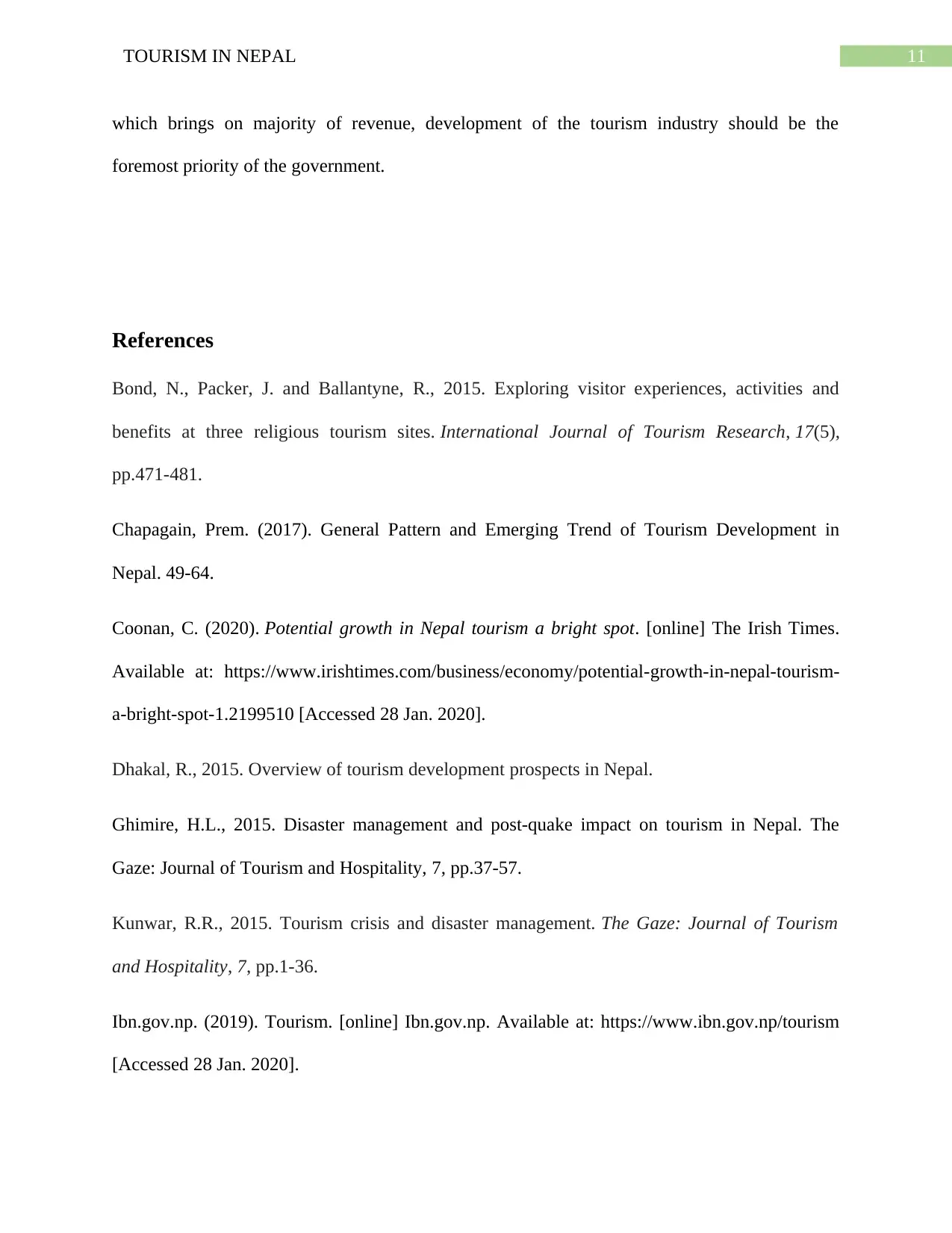
11TOURISM IN NEPAL
which brings on majority of revenue, development of the tourism industry should be the
foremost priority of the government.
References
Bond, N., Packer, J. and Ballantyne, R., 2015. Exploring visitor experiences, activities and
benefits at three religious tourism sites. International Journal of Tourism Research, 17(5),
pp.471-481.
Chapagain, Prem. (2017). General Pattern and Emerging Trend of Tourism Development in
Nepal. 49-64.
Coonan, C. (2020). Potential growth in Nepal tourism a bright spot. [online] The Irish Times.
Available at: https://www.irishtimes.com/business/economy/potential-growth-in-nepal-tourism-
a-bright-spot-1.2199510 [Accessed 28 Jan. 2020].
Dhakal, R., 2015. Overview of tourism development prospects in Nepal.
Ghimire, H.L., 2015. Disaster management and post-quake impact on tourism in Nepal. The
Gaze: Journal of Tourism and Hospitality, 7, pp.37-57.
Kunwar, R.R., 2015. Tourism crisis and disaster management. The Gaze: Journal of Tourism
and Hospitality, 7, pp.1-36.
Ibn.gov.np. (2019). Tourism. [online] Ibn.gov.np. Available at: https://www.ibn.gov.np/tourism
[Accessed 28 Jan. 2020].
which brings on majority of revenue, development of the tourism industry should be the
foremost priority of the government.
References
Bond, N., Packer, J. and Ballantyne, R., 2015. Exploring visitor experiences, activities and
benefits at three religious tourism sites. International Journal of Tourism Research, 17(5),
pp.471-481.
Chapagain, Prem. (2017). General Pattern and Emerging Trend of Tourism Development in
Nepal. 49-64.
Coonan, C. (2020). Potential growth in Nepal tourism a bright spot. [online] The Irish Times.
Available at: https://www.irishtimes.com/business/economy/potential-growth-in-nepal-tourism-
a-bright-spot-1.2199510 [Accessed 28 Jan. 2020].
Dhakal, R., 2015. Overview of tourism development prospects in Nepal.
Ghimire, H.L., 2015. Disaster management and post-quake impact on tourism in Nepal. The
Gaze: Journal of Tourism and Hospitality, 7, pp.37-57.
Kunwar, R.R., 2015. Tourism crisis and disaster management. The Gaze: Journal of Tourism
and Hospitality, 7, pp.1-36.
Ibn.gov.np. (2019). Tourism. [online] Ibn.gov.np. Available at: https://www.ibn.gov.np/tourism
[Accessed 28 Jan. 2020].
⊘ This is a preview!⊘
Do you want full access?
Subscribe today to unlock all pages.

Trusted by 1+ million students worldwide
1 out of 13
Related Documents
Your All-in-One AI-Powered Toolkit for Academic Success.
+13062052269
info@desklib.com
Available 24*7 on WhatsApp / Email
![[object Object]](/_next/static/media/star-bottom.7253800d.svg)
Unlock your academic potential
Copyright © 2020–2025 A2Z Services. All Rights Reserved. Developed and managed by ZUCOL.




